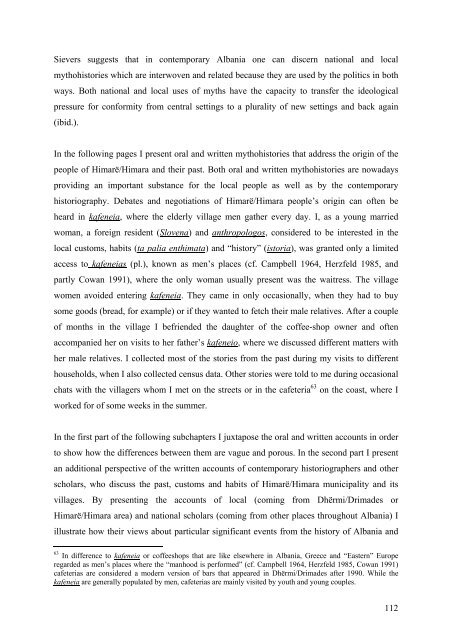university of nova gorica graduate school contested spaces and ...
university of nova gorica graduate school contested spaces and ...
university of nova gorica graduate school contested spaces and ...
You also want an ePaper? Increase the reach of your titles
YUMPU automatically turns print PDFs into web optimized ePapers that Google loves.
Sievers suggests that in contemporary Albania one can discern national <strong>and</strong> local<br />
mythohistories which are interwoven <strong>and</strong> related because they are used by the politics in both<br />
ways. Both national <strong>and</strong> local uses <strong>of</strong> myths have the capacity to transfer the ideological<br />
pressure for conformity from central settings to a plurality <strong>of</strong> new settings <strong>and</strong> back again<br />
(ibid.).<br />
In the following pages I present oral <strong>and</strong> written mythohistories that address the origin <strong>of</strong> the<br />
people <strong>of</strong> Himarë/Himara <strong>and</strong> their past. Both oral <strong>and</strong> written mythohistories are nowadays<br />
providing an important substance for the local people as well as by the contemporary<br />
historiography. Debates <strong>and</strong> negotiations <strong>of</strong> Himarë/Himara people’s origin can <strong>of</strong>ten be<br />
heard in kafeneia, where the elderly village men gather every day. I, as a young married<br />
woman, a foreign resident (Slovena) <strong>and</strong> anthropologos, considered to be interested in the<br />
local customs, habits (ta palia enthimata) <strong>and</strong> “history” (istoria), was granted only a limited<br />
access to kafeneias (pl.), known as men’s places (cf. Campbell 1964, Herzfeld 1985, <strong>and</strong><br />
partly Cowan 1991), where the only woman usually present was the waitress. The village<br />
women avoided entering kafeneia. They came in only occasionally, when they had to buy<br />
some goods (bread, for example) or if they wanted to fetch their male relatives. After a couple<br />
<strong>of</strong> months in the village I befriended the daughter <strong>of</strong> the c<strong>of</strong>fee-shop owner <strong>and</strong> <strong>of</strong>ten<br />
accompanied her on visits to her father’s kafeneio, where we discussed different matters with<br />
her male relatives. I collected most <strong>of</strong> the stories from the past during my visits to different<br />
households, when I also collected census data. Other stories were told to me during occasional<br />
chats with the villagers whom I met on the streets or in the cafeteria 63 on the coast, where I<br />
worked for <strong>of</strong> some weeks in the summer.<br />
In the first part <strong>of</strong> the following subchapters I juxtapose the oral <strong>and</strong> written accounts in order<br />
to show how the differences between them are vague <strong>and</strong> porous. In the second part I present<br />
an additional perspective <strong>of</strong> the written accounts <strong>of</strong> contemporary historiographers <strong>and</strong> other<br />
scholars, who discuss the past, customs <strong>and</strong> habits <strong>of</strong> Himarë/Himara municipality <strong>and</strong> its<br />
villages. By presenting the accounts <strong>of</strong> local (coming from Dhërmi/Drimades or<br />
Himarë/Himara area) <strong>and</strong> national scholars (coming from other places throughout Albania) I<br />
illustrate how their views about particular significant events from the history <strong>of</strong> Albania <strong>and</strong><br />
63 In difference to kafeneia or c<strong>of</strong>feeshops that are like elsewhere in Albania, Greece <strong>and</strong> “Eastern” Europe<br />
regarded as men’s places where the “manhood is performed” (cf. Campbell 1964, Herzfeld 1985, Cowan 1991)<br />
cafeterias are considered a modern version <strong>of</strong> bars that appeared in Dhërmi/Drimades after 1990. While the<br />
kafeneia are generally populated by men, cafeterias are mainly visited by youth <strong>and</strong> young couples.<br />
112

















